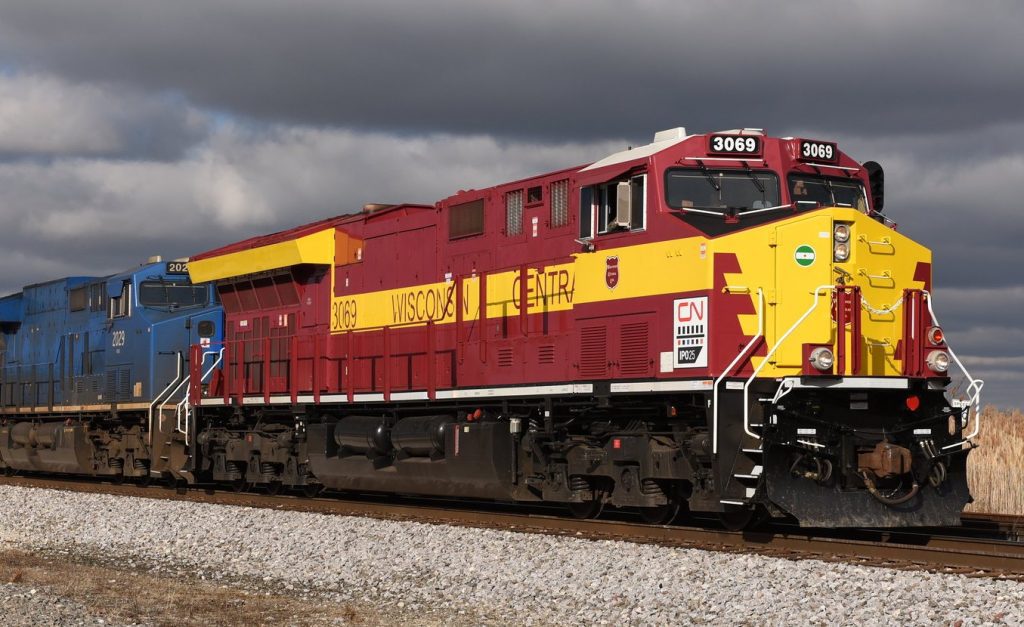
Last week I got this flier which is being circulated around Wisconsin trying to stop the bi-partisan effort to ban coal tar and high polycyclic aromatic hydrocarbon (PAH) asphalt sealers in that state. Last session it passed the State Assembly unanimously before the session ended because of the pandemic.
That was the first time that any state-level chamber unanimously passed coal tar legislation and it is tribute to the work put in by members of both parties who held listening sessions around the state about what can be done to protect Wisconsin water resources.
In order to address these industry comments I have sliced up their document and will address each of their issues. For clarity, the industry comments are in a double-lined border.
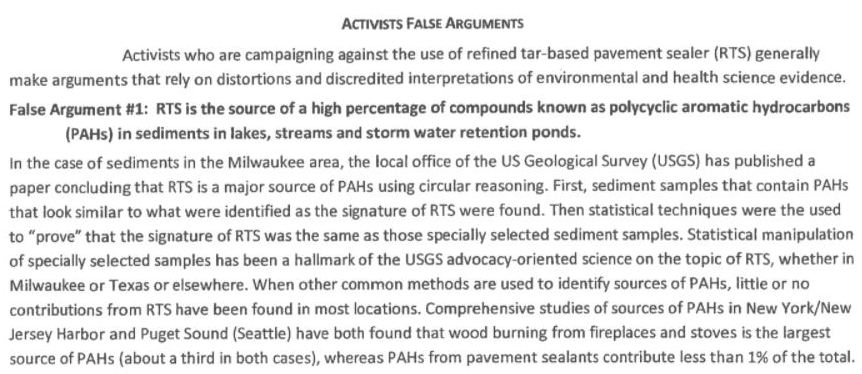
This is a classic distraction argument. They would like to have an argument over statistical methods to distract from the simple fact that when compared to other mobile sources of PAHs, coal tar pavement sealers are some of the most potent, mobile sources, as you can see in the following table. And they have to be replaced every few years.
In more than 15 years the sealcoat industry has offered no coherent explanation about where their product goes when it is worn off of pavement, but have actually blamed high PAHs in streams on volcanoes and space dust. [Reference 1]

Industry also misquotes the New York Academy of Sciences finding re: the Harbor Study for PAHs in 2007. They cite the level of PAHs emitted (gray bars in graphic below), not the effective loading (black bars in the same graphic) to the Harbor . This image is clipped directly from the report. Note that the largest single source for effective loading is coal tar sealers, not wood burning stoves.
The following pie chart uses this data to more clearly show the loading and differences. The largest single source is coal tar sealers at 38% in the most compact urban area in our nation with the fewest surface parking lots per capita. [Reference 2]
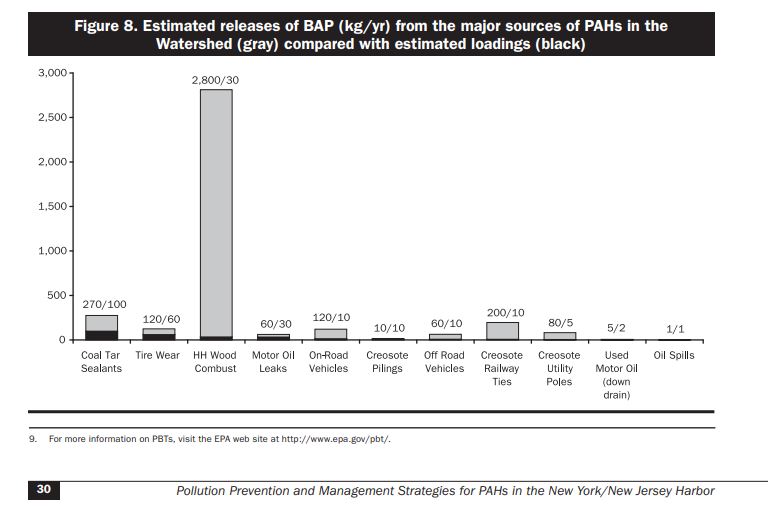
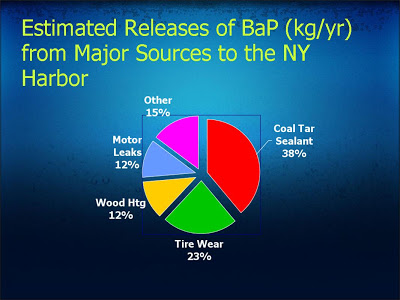
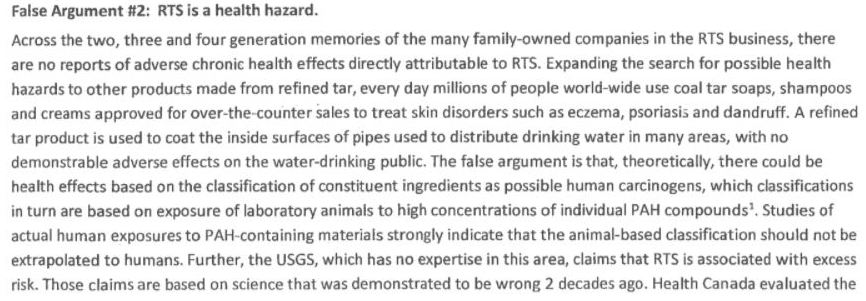
Well the most respected group of doctors in the United States, the AMA, says that it should be banned. Do you want to know more than that? [Reference 3]
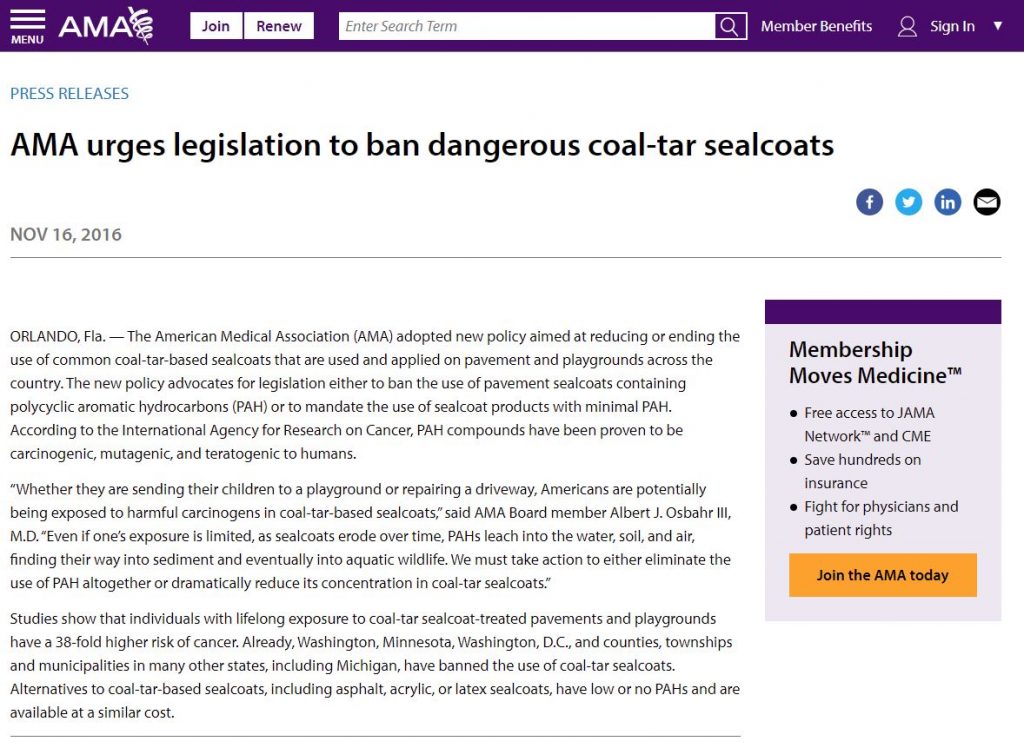

This is a classic straw man argument. No one claims that PAHs from coal tar sealers are contaminating water supplies. The biggest risk to the human community is children playing or living near coal tar sealer surfaces. Period.
We consistently argue that the impairment of the ecosystem begins in sediment, not in water. In other words they are trying to counter an argument no one is making.

The old expression is that if it looks like a duck, quacks likes a duck and swims like a duck, then that is what is probably is.
What is the number 1 most common contaminant the United States has cleaned up at hazardous waste facilities?
Coal tar.
What contaminant was responsible for the largest fine in EPA history?
Coal tar.
What contaminant required a special exception from the EPA so that it wouldn’t be classified as hazardous waste?
Coal tar.

These statements here are full of outdated, false notions.
First of all, Home Depot and Lowes stopped selling coal tar sealers more than a decade ago. In 2007, I worked with the City of Austin team advising the New York Academy of Sciences on PAH pollution in the NY Harbor. At those meetings, the Chief Sustainability Officer for Lowes, Michael Chennard, said that they stopped selling coal tar sealants after learning about it from Austin, based upon a business model. Here’s the Lowes’ equation:
1. Identify products that have a high potential liability. He said their pockets were now deeper than many of their suppliers, so they have more to lose.
2. Find out if there are suitable alternatives in quality and price.
3. If both the quality and prices are similar, then remove the problematic product from the shelves
The one-time great benefit of coal tar sealer being fuel resistant no longer matters. Fuel resistant, hot mix asphalt is currently being used around the country.[Reference 4]
They mention there is no standard for asphalt based sealcoat. It actually was developed by the Asphalt Sealcoat Manufacturer’s Association more than 20 years ago. Below is the heading clipped from that standard. [Reference 5]
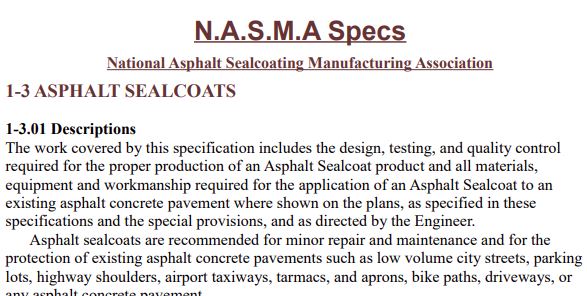

The main point of this section is the claim that sealcoater’s business will drop 20% if a ban goes into effect.
There are two angles to approach this. First, the owner of a franchise sealcoat business with locations in Wisconsin, Michigan, Minnesota, Illinois, South Dakota and 13 other states said that banning coal tar sealer would not affect their business in the long run. Specifically Nick Kelso of Jet-Black said:
“There are pros and cons to both,” Kelso said. “We don’t think (the bans) will affect business in the long-term.” [Reference 6]
Second, the prospects are good for the sealer industry in the US even without coal tar.
A market research company recently confirmed what one CEO of a sealer company said a few years ago: bans really won’t hurt the sealcoat business.
In the projected period through 2027, the industry is expected to experience “moderate growth” but “rising bans on coal tar-based sealers, the improved performance of asphalt-based sealers, and competitive pricing are expected to result in the increased consumption of bitumen and asphalt sealers…” [Reference 7]
Train Photo by Mark Loewe on Flickr
References
Reference 1: Industry webinar. https://coaltarfreeusa.com/2013/02/space-junk-volcanoes-and-coal-tar-sealers-industry-webinar-to-stop-bans-has-some-surprises/
Reference 2: Pollution Prevention and Management Strategies for Polycyclic Aromatic Hydrocarbons in the New York/New Jersey Harbor, New York Academy of Sciences, 2007. https://austintexas.gov/sites/default/files/files/Watershed/coaltar/nyas_pah_harbor_study_final.pdf
Reference 3: AMA Press Release 2016: https://www.ama-assn.org/press-center/press-releases/ama-urges-legislation-ban-dangerous-coal-tar-sealcoats
Reference 4: Bob Sikes Airport Installs New Fuel Resistant Asphalt, Airport Improvement Magazine, July-August 2012. https://airportimprovement.com/drupal778/index.php/bob-sikes-airport-installs-new-fuel-resistant-asphalt?q=article/bob-sikes-airport-installs-new-fuel-resistant-asphalt
Reference 5: National Asphalt Sealcoat Manufacturers’ Standard Specification. http://www.sealcoatmfg.org/asma-spec.pdf
Reference 6: Quad City Press, March 16, 2011. https://www.presspubs.com/quad/news/tar-sealant-still-ok-for-lino-driveways/article_679065f5-0868-54f6-83ec-b6c9c2f22dbb.html
Reference 7: http://www.transparencymarketresearch.com/north-america-sealers-market.html
